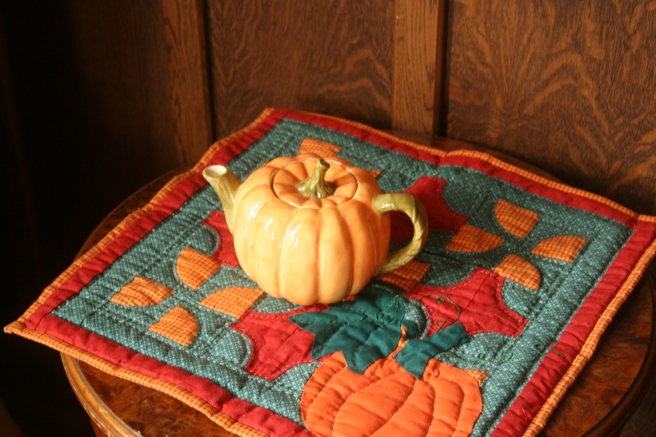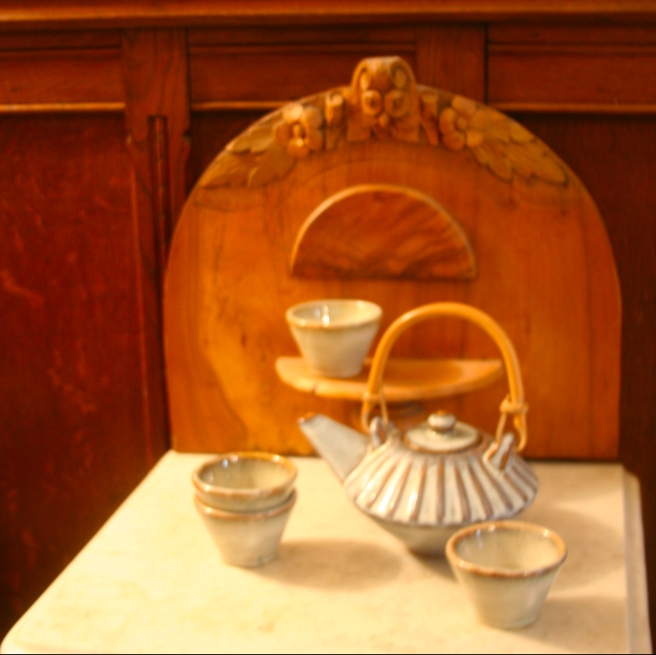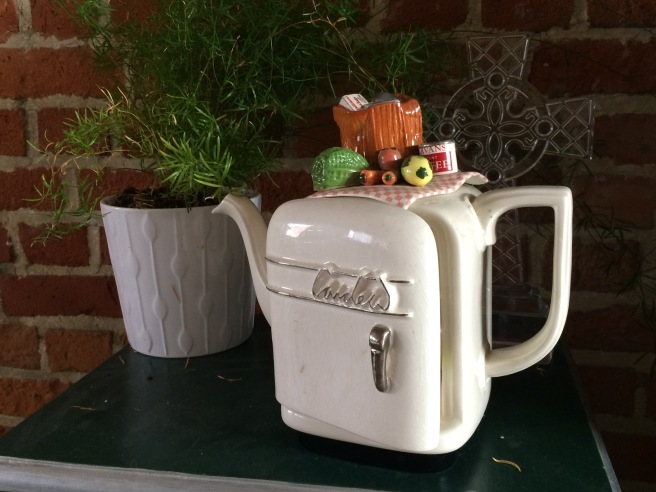Since I have become engrossed in these blogs on Worship Pathways (inspired by Gary Thomas’ book Sacred Pathways and our summer series at The Well), I have neglected the tea side of this blog. I thought maybe it was time to remedy that, and began to wonder: which of my personal teapots might best represent people with different worship pathway preferences? After all, if we are all “little teapots” made as masterpieces by the Potter to pour out the good works he has made for us to do (as I suggest in my “About THÉology” page), then perhaps we might be able to picture these teapots as having different personalities… Here are my picks (and pics). What thoughts do you have? What kind of “little teapot” are you?
The Naturalist Teapot

This little pumpkin teapot, given to me by a former piano student, is sitting on a quilted wall hanging that I made for autumn-time. I picked this teapot because the Naturalist sees the glory of God in all his creation, even a humble pumpkin—and is aware of God’s having made him, also, as a vessel designed to show His glory. (I will be writing about this pathway shortly.)
The Ascetic Teapot

I purchased this little pot, in the shape of an alarm clock, for a couple of euros at a flea market. Like the Ascetic, it celebrates the simple in its design and decoration, and values the discipline of regular time set aside for contemplation. (The clock at rear is an antique that used to belong to John Dunlap, the pastor that founded our home church in Virginia.)
The Contemplative Teapot

Considering the Contemplative made me think of the simplicity of Chinese tea—the way it should be served without additives and savored in small cups. One is meant to take the tea as a time to be present in the moment, with whoever is in company, just as the Contemplative meditates with mindfulness on God and savors His presence. Thus I have chosen for this pathway a simple Chinese tea set given to me by a friend who stayed in our home.
The Caregiver Teapot
I have not yet written about this Pathway, but for me the perfect Biblical example of a Caregiver, who loves God through loving others, is Dorcas. She “was always doing good and helping the poor” (Acts 9:36), and one way she cared for these individuals was by making clothes for them. So the natural teapot to choose was one of my smallest: a sewing machine teapot made by my favorite teapot designer, Paul Cardew. (It is pictured here with my daughter’s antique Singer machine, which I am keeping for her as she travels around South America.)
The Activist Teapot

This is one of my very favorite teapots, also by Paul Cardew, and bought for me by my husband Carlton in London many years ago. This teapot also reminds me of my Activist husband, who loves God through social justice—especially as he leads his Breakfast 4 Refugees project each Monday and Tuesday mornings. He and his team serve coffee, bread, and fruit to those waiting in line to apply for asylum at the Foreigners Office in Brussels, as well as to many Sudanese migrants living in the park opposite. This generosity of sharing God’s resources seems appropriate to attach to an overflowing refrigerator with more groceries to add.
The Traditionalist Teapot

The Traditionalist, as we have seen, loves God through ritual and symbol, and loves to locate him/herself in the long history of dealing with God’s people. This made me think of two of my favorite teapots, both from Nyon, Switzerland (near Geneva, where we once lived). They are both hand-painted with traditional cornflowers, symbolic motifs used in Nyon since porcelain began to be produced there 250 years ago. The small one on the left was given to me by my dear Swiss friend, Anne-Marie Andre (very much a Caregiver), while the left-hand one was commissioned as a gift for me by my Kindermusik students when I left in 2002. (It is the most valuable teapot I own.) I also thought of the English ritual of tea with its long history, as exemplified by the two Spode pieces pictured here, the creamer and the cake plate.
The Enthusiast Teapot

This little teapot, a gift from my mother-in-law, makes me think of a verse from Psalm 104, that wonderful Psalm of provision: He makes grass grow for the cattle, and plants for people to cultivate—bringing forth food from the earth: wine that gladdens human hearts, oil to make their faces shine, and bread that sustains their hearts (v.14-15). Wine is something we use to celebrate, but Scripture shows us an even better way: Do not get drunk on wine… Instead, be filled with the Spirit... Sing and make music from your heart to the Lord, always giving thanks to God the Father for everything, in the name of our Lord Jesus Christ (Ephesians 5:18-20). This perfectly captures the spirit of the Enthusiast worshipper (the subject of my next blog in the series).
The Sensate Teapot

I could, in some ways, have chosen any of my teapots to symbolize the Sensate, as all of them are interesting aesthetically. But I finally narrowed it down to my Tony Carter “Tea Party” teapot, a gift from my husband. (The Art Deco espresso cup next to the pot is Limoges.) I picked this pot because the Sensate worshipper loves to taste the glory of God in a banquet of the senses, whether through art or through the simple pleasures of touch, taste, sound, smell, and sight in daily living.
The Intellectual Teapot

Last but not least, I have chosen this Tony Carter teapot to depict the Intellectual Pathway, placed as it is in front of a set of the Great Books of the Western World. The Intellectual loves God with all his/her mind, finding that “all truth is God’s truth” in the world, and discovering in truth a beauty that leads to worship. This is also, as you might have noticed, the teapot that I have used as the featured image for this blog on THÉology…
So, once again… what kind of little teapot are you?
I would like to thank Robin Christofi, who took many of these pictures of my teapots back in 2014.
Categories: Creative Worship Personal Discovery Tea & Tidbits

Leave a comment